Did you know that Africa is home to over 500 species of African Finches? These exquisite birds captivate enthusiasts with their vibrant colors, melodious songs, and unique behaviors. From the dazzling Waxbill to the striking Firefinch, African Finches offer a stunning array of species to explore. If you’re ready to embark on a birdwatching adventure like no other, join us as we introduce you to 12 exotic African Finches that will leave you in awe.
1. Genus Amadina
Discover the fascinating Genus Amadina, home to two striking finch species – the Cut-throat Finch (Amadina fasciata) and the Red-headed Finch (Amadina erythrocephala).
1.1 Cut-throat Finch
The Cut-throat Finch, also known as the Red-headed Finch, is a popular choice among bird enthusiasts due to its vibrant plumage and unique appearance. With its bright red head contrasting against a white face and black mask, this finch stands out in any aviary or garden.

Cut-throat Finch is native to sub-Saharan Africa and is a social bird, often seen in small flocks. Male finches are known for their elaborate courtship displays, which involve puffing up their chest feathers and performing intricate dance moves to attract a mate.
1.2 Red-headed Finch
The Red-headed Finch flaunts a stunning red crown on its head, which sets it apart from other finch species. Its body is primarily olive green, creating a contrasting yet harmonious color combination. This finch is known for its melodious song, making it a delightful addition to any bird lover’s collection.
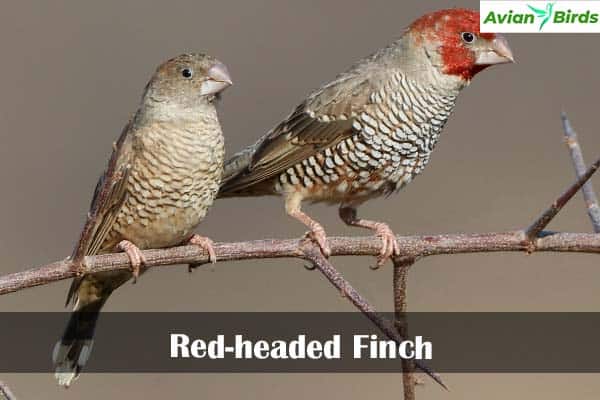
If you’re considering adding a vibrant and charismatic finch to your aviary or garden, the Genus Amadina offers two excellent choices. The Cut-throat Finch and the Red-headed Finch will not only captivate you with their colors but also delight you with their cheerful songs.
2. Genus Amandava
Explore the Genus Amandava and discover the captivating beauty of the Orange-breasted Waxbill (Amandava subflava). With its vibrant plumage and charming demeanor, this species is a favorite among bird enthusiasts.
The Genus Amandava belongs to the family Estrildidae and is native to sub-Saharan Africa. This genus is renowned for its diverse and colorful members, but none quite so captivating as the Orange-breasted Waxbill.
2.1 Orange-breasted Waxbill
The Orange-breasted Waxbill is a small bird, measuring just 9-10 centimeters in length. It is characterized by its bright orange breast, contrasting with its olive-green back and wings. The male of the species sports a crimson mask around its eyes, adding to its visual appeal.

This species is primarily found in grassland habitats, where it can be seen foraging for seeds and insects. It is often spotted in pairs or small flocks, chirping away in melodious calls. The Orange-breasted Waxbill is also known for its unique courtship display, where the male presents grass stems to the female.
If you’re considering keeping the Orange-breasted Waxbill as a pet, it’s important to provide them with a spacious aviary. They thrive in social environments, so be sure to keep them in pairs or small groups. A diet consisting of a variety of seeds and insects will help them maintain their vibrant plumage and overall health.
Overall, the Genus Amandava offers bird enthusiasts the opportunity to witness the captivating beauty of the Orange-breasted Waxbill. Whether in the wild or as pets, these birds are sure to bring joy and awe with their vibrant colors and charming behaviors.
3. Genus Brunhilda
Explore the remarkable Genus Brunhilda, home to the stunning Black-cheeked Waxbill (Brunhilda charmosyna) and the captivating Black-faced Waxbill (Brunhilda erythronotos). These two species, known for their distinct markings and vibrant plumage, are a sight to behold for any birdwatching enthusiast.
3.1 Black-cheeked Waxbill

The Black-cheeked Waxbill, also known as the “Genus Brunhilda Waxbill,” is named for its striking black cheeks that contrast beautifully with its reddish-brown back and wings. It features a bright red bill and a white patch around the eye, adding to its allure. Found in the grasslands and savannahs of West Africa, this small finch is a delightful addition to any avian collection.
3.2 Black-faced Waxbill
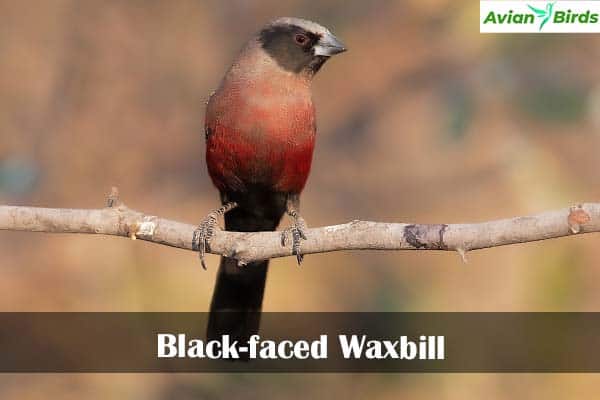
The Black-faced Waxbill, another member of the Genus Brunhilda, boasts a captivating appearance with a black face, white throat, and rich chestnut-colored body. Its unique combination of colors makes it a standout among other finches. Native to the tropical forests of Central Africa, this waxbill is a testament to the beauty and diversity found within the African finch family.
4. Genus Clytospiza
Discover the fascinating Genus Clytospiza, known for its unique bird species like the Brown Twinspot (Clytospiza monteiri). This remarkable bird showcases distinctive markings that make it a true standout in the avian world.
4.1 Brown Twinspot
The Brown Twinspot is a small passerine bird native to certain regions of Africa. Its scientific name, Clytospiza monteiri, pays homage to the renowned ornithologist António Monteiro who made significant contributions to the study of African birds.
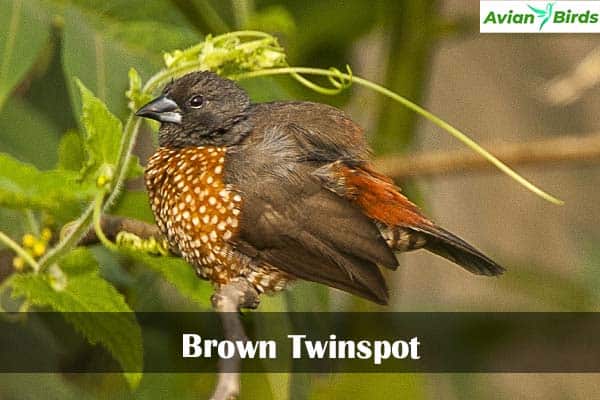
With its beautiful brown plumage, the Brown Twinspot captivates bird enthusiasts and researchers alike. This species is known for its intricate patterns and markings, which differ between males and females.
Males feature a prominent dark brown coloration on their upperparts, gradually blending into a lighter brown on the underparts. The wings and tail are adorned with intricate patterns in shades of brown, giving them a captivating appearance. Additionally, the males display a striking red crown, contrasting beautifully with the rest of their plumage.
Females, on the other hand, have a more subdued coloration, with a lighter brown overall and less prominent patterns. Their plumage helps them blend into their surroundings, providing camouflage and protection against predators.
The Brown Twinspot is typically found in grassland and savannah habitats, where it forages for seeds on the ground. Its diet consists mainly of grass and shrub seeds, which it adeptly cracks open using its specialized beak.
During the mating season, the males engage in impressive courtship displays to attract females. Their displays involve fluttering flights, song duets, and striking poses to show off their vibrant plumage.
| Species | Scientific Name |
|---|---|
| Brown Twinspot | Clytospiza monteiri |
The Brown Twinspot is a testament to the incredible diversity of bird species in the Genus Clytospiza. Its unique characteristics and striking appearance make it a beloved subject for birdwatchers and photographers.
Stay tuned for the upcoming sections to explore more fascinating African finches and their captivating features.
5. Genus Coccopygia
Welcome to the fascinating world of the Genus Coccopygia, where you’ll encounter a trio of colorful and captivating waxbill species. Get ready to admire the beauty and uniqueness of the Angola Waxbill, the Swee Waxbill, and the Yellow-bellied Waxbill.
5.1 Angola Waxbill (Coccopygia bocagei)
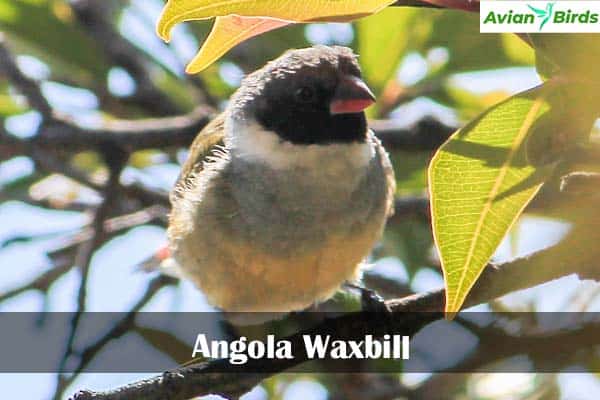
The Angola Waxbill, also known as Bocage’s Waxbill, is a strikingly beautiful bird with its vibrant plumage and a charming personality. Found in Angola and parts of the Democratic Republic of the Congo, this small finch showcases a combination of earthy tones and delicate patterns. Its distinctive orange-brown back, chestnut-colored crown, and white belly make the Angola Waxbill a true gem to behold.
5.2 Swee Waxbill (Coccopygia melanotis)

If you’re looking for a bird that exudes charm and elegance, the Swee Waxbill is sure to steal your heart. Sporting a stunning plumage of soft browns, grays, and ochres, this small finch native to Ethiopia and Somalia showcases intricate feather patterns and a glossy black tail. Its warm colors and adorable appearance make the Swee Waxbill an absolute delight for birdwatchers and nature enthusiasts.
5.3 Yellow-bellied Waxbill (Coccopygia quartinia)

Prepare to be enchanted by the vibrant beauty of the Yellow-bellied Waxbill. Endemic to Mozambique and Zimbabwe, this little finch features a striking combination of colors. Its genial yellow underparts contrast beautifully with its darker upperparts, creating a visual spectacle that is hard to miss. The Yellow-bellied Waxbill’s cheerful demeanor and bright plumage make it an absolute joy to observe.
Genus Coccopygia
Each of these waxbill species within the Genus Coccopygia represents a remarkable example of avian diversity. From the Angola Waxbill’s earthy tones to the Swee Waxbill’s elegance and the Yellow-bellied Waxbill’s vibrant hues, exploring the Genus Coccopygia promises an incredible journey into the world of these charismatic finches.
| Species | Scientific Name | Native Range |
|---|---|---|
| Angola Waxbill | Coccopygia bocagei | Angola, Democratic Republic of the Congo |
| Swee Waxbill | Coccopygia melanotis | Ethiopia, Somalia |
| Yellow-bellied Waxbill | Coccopygia quartinia | Mozambique, Zimbabwe |
6. Genus Cryptospiza
Discover the diverse Genus Cryptospiza, home to a stunning array of crimsonwing finches. These unique and enchanting birds will captivate birdwatchers and enthusiasts alike with their vibrant plumage and intriguing behaviors.
6.1 Abyssinian Crimsonwing (Cryptospiza salvadorii)
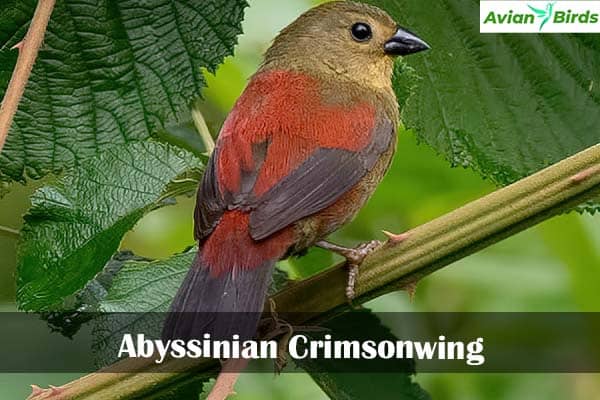
The Abyssinian Crimsonwing is a true gem, with its deep crimson feathers and iridescent blue-black undertones. Found primarily in the montane forests of Ethiopia, this species is known for its distinctive mating dance, where males display their crimson plumage in an elaborate courtship ritual.
6.2 Dusky Crimsonwing (Cryptospiza jacksoni)
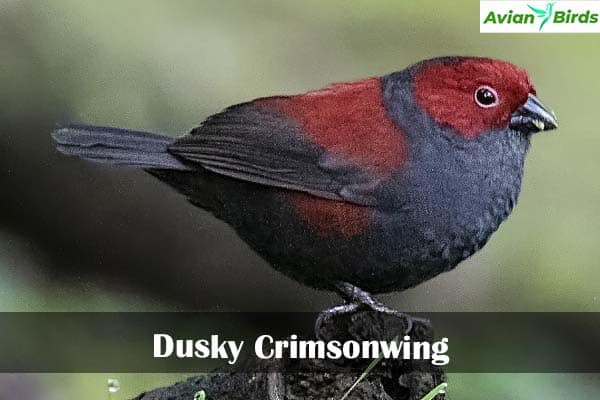
The Dusky Crimsonwing is a sight to behold, with its dusky brown plumage and striking crimson throat. Native to the East African highlands, this species has adapted to the cool montane habitats, where it forages on seeds and insects.
6.3 Red-faced Crimsonwing (Cryptospiza reichenovii)

The Red-faced Crimsonwing is a colorful finch characterized by its crimson face and vibrant yellow underparts. This species is found in the bamboo forests of East Africa, where it feeds on bamboo seeds and insects.
6.4 Shelley’s Crimsonwing (Cryptospiza shelleyi)
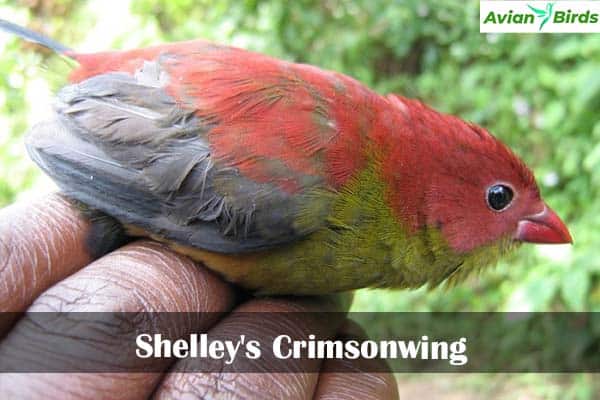
Shelley’s Crimsonwing is a beautiful finch with its crimson plumage and contrasting black wings. Endemic to the highlands of Tanzania, this species is known for its preference for mossy habitats and is often found in the vicinity of water bodies.
Whether you’re a seasoned birdwatcher or a beginner, encountering the fascinating finches of the Genus Cryptospiza is an experience that will leave you in awe. Their striking colors and unique behaviors make them a true delight to observe in the wild.
7. Genus Delacourella
Discover the fascinating Genus Delacourella, known for its elegant species, including the Grey-headed Oliveback (Delacourella capistrata). This small finch, native to certain regions of Africa, showcases distinctive plumage that sets it apart from other species in its genus.
7.1 Grey-headed Oliveback

The Grey-headed Oliveback, also known as the Grey-headed Silverbill, sports a captivating color palette. The male bird features a combination of grey on its head, olive green on its back, and white on its underparts, while the female has a more subdued coloration. This striking contrast makes it a visually appealing species to observe in the wild.
Like other finches, the Grey-headed Oliveback primarily feeds on grass seeds and small insects. Its versatile diet allows it to thrive in various habitats, including grasslands, woodlands, and savannas. Its adaptability to different environments also contributes to its wide distribution across parts of West Africa.
Conservation status
The Grey-headed Oliveback faces several threats to its population. Habitat loss due to urbanization, agriculture, and deforestation poses a significant risk to this species. Additionally, capture for the pet trade and competition from invasive species have further impacted their numbers in certain regions.
Conservation efforts, such as habitat preservation and education about the importance of protecting these birds, are vital in supporting the survival of the Grey-headed Oliveback and other african finches within the Genus Delacourella.
| Species | Scientific Name | Conservation Status |
|---|---|---|
| Grey-headed Oliveback | Delacourella capistrata | Least Concern |
The table above summarizes the current conservation status of the Grey-headed Oliveback. Despite facing threats, this species is currently classified as “Least Concern” according to the International Union for Conservation of Nature (IUCN). However, continued monitoring and conservation efforts are imperative to ensure the long-term survival of this fascinating finch.
Check Our Previous Articles:
8. Genus Estrilda
Continue your journey through the fascinating world of African finches with the diverse Genus Estrilda. This genus is home to a variety of captivating species, including the beloved Common Waxbill, the vibrant Crimson-rumped Waxbill, and the charming Fawn-breasted Waxbill.
8.1 Common Waxbill
The Common Waxbill (Estrilda astrild) is a popular choice among bird enthusiasts. With its beautiful combination of brown, gray, and red plumage, it adds a touch of elegance to any aviary. Known for its cheerful demeanor and melodious song, this species is a delightful addition to any birdwatcher’s collection.

Another eye-catching member of the Genus Estrilda is the Crimson-rumped Waxbill (Estrilda rhodopyga). As its name suggests, this species showcases a vibrant crimson-colored rump that is sure to capture attention. Its colorful plumage, combined with its active nature, makes it a true standout among finches.
8.2 Fawn-breasted Waxbill
Lastly, we have the charming Fawn-breasted Waxbill (Estrilda paludicola), a delightful species known for its warm brown plumage and endearing courtship displays. This small waxbill captivates with its gentle nature and intricate feather patterns.

Within the Genus Estrilda, you will also find various other species, each with its unique characteristics and beauty. Whether you are a seasoned birdwatcher or just starting your journey, exploring the diverse finches of the Estrilda genus will undoubtedly bring you joy and wonder.
Frequently Asked Questions
Q1. What is the lifespan of an African finch?
African finches typically live for about 5 to 8 years.
Q2. What is the range of the African firefinch?
The African firefinch is found across sub-Saharan Africa.
Q3. What is so special about African Finches?
African Finches are known for their diverse beak shapes and sizes, adapted for various diets and habitats.
Q4. Is Finch a parrot?
No, finches are not parrots. They belong to a different group of birds known as Passerines.





Add comment